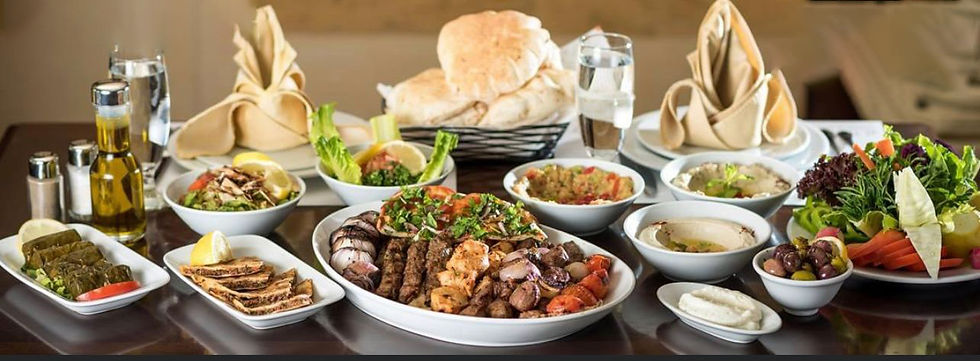Exploring the Rich History of Turkish Culinary Traditions
- cappadociasg
- Apr 28
- 4 min read
Turkish cuisine is a vibrant tapestry woven from a rich history of diverse cultures and influences. It showcases a myriad of flavors, techniques, and ingredients that reflect the country's dynamic geography and historical interactions. From the bustling markets of Istanbul to the tranquil shores of the Aegean, each dish tells a story, presenting a legacy that has evolved over centuries.
Turkish Cuisine
At its core, Turkish cuisine is a fusion of Central Asian, Middle Eastern, Mediterranean, and Balkan influences. This blend is not only a testament to the migration patterns of the Turkish people but also an indication of how accessible it is to various cultures. To truly appreciate Turkish cuisine, one must explore its most vital components: grains, vegetables, meats, and spices.
Key Ingredients and Their Significance
Turkish cuisine heavily relies on several staple ingredients, each playing a crucial role in its signature dishes.
Grains: Wheat is the backbone of Turkish carbohydrates, used predominantly in bread, pilaf, and other dishes. Flatbreads like pide and lavash are commonplace, complemented by rice dishes that are often made with spices and herbs for added flavor.
Vegetables: Vegetables like eggplants, tomatoes, and peppers are central players in many Turkish recipes. They can be grilled, roasted, or stuffed, showcasing the versatility of simple ingredients. For example, Dolma, stuffed grape leaves with a mixture of rice, nuts, and spices, highlight how vegetables can serve as a canvas for richer flavors.
Meat: Lamb and beef are the most common proteins, often marinated with a blend of spices before grilling or slow-cooking. Dishes like Kebab represent the heart of Turkish gastronomy, with regional variations across the country.
Spices: Spices such as cumin, paprika, and sumac are crucial in creating the distinct flavors found in Turkish dishes. They reflect the country's historical trade connections, bringing wealth and variety to the culinary landscape.

Historical Influences on Turkish Cuisine
The evolution of Turkish cuisine can be traced through various historical epochs. The Ottoman Empire, spanning over six centuries, played a pivotal role in shaping culinary practices. The palace kitchens provided an environment for culinary exploration that integrated flavors from the empire’s extensive reach, from the Balkans to the Middle East.
The opulent dining of the sultans meant that lavish ingredients like saffron, almonds, and dried fruits found their way into everyday cooking. This grandeur made its way down to the citizens, enhancing local home cooking methods and recipes.
Moreover, the introduction and integration of coffee and tea culture—especially the famous Turkish coffee—further diversified food and drink practices. Coffeehouses in the 16th century became social hubs and laid the groundwork for contemporary coffee culture.

Cultural Significance of Turkish Dishes
Many Turkish dishes carry cultural significance, often associated with holidays, celebrations, and family gatherings. For instance, Kebabs are a staple at family barbecues, while sweets like Baklava and Turkish Delight are served during holidays and special occasions. They symbolize hospitality and are often offered to guests as a dessert.
Another noteworthy dish is Meze, a selection of small plates served as appetizers, reflecting the importance of sharing and community in Turkish dining. This communal aspect of eating encapsulates the essence of Turkish culture—bringing people together over food.
Regional Variations in Turkish Cuisine
Turkey's diverse geography also results in remarkable regional variations. The coastal areas are rich in seafood, while Anatolia is known for its hearty stews and warming dishes.
Aegean Region: Known for its olive oil-based dishes featuring fresh vegetables and herbs. Mezes from this area often highlight light and zesty flavors.
Eastern Turkey: Notable for its spicy dishes and rich meat options. Dishes like Kebab and Kuzu tandir (slow-cooked lamb) are prevalent.
Black Sea Region: Famous for its fish and maize-based dishes. This area offers unique delicacies such as Mıhlama, a cheesy cornmeal dish.
Central Anatolia: Offers heartier fare, including mantı (Turkish dumplings) and various types of bread. The use of yogurt is also a staple here, often accompanying meals.
Exploring these regional flavors provides an insight into the local customs and traditions, enriching the overall understanding of Turkish cuisine.

Savoring Turkish Cuisine Today
Today, you can experience Turkish cuisine in various forms worldwide, but nothing compares to the authenticity found in Turkey itself. Visiting a local turkish restaurant can provide an immersive experience, allowing you to indulge in the flavors and techniques that have been passed down through generations.
For those who wish to learn at home, there are abundant resources available, from cookbooks to online tutorials. Mastering iconic dishes such as İskender Kebap or making a perfect baklava can serve as a delightful journey into Turkey’s culinary heart.
As you explore Turkish cuisine, consider hosting a meze night with friends or experimenting with spices in your own cooking. Not only does cooking at home offer a chance to connect with the food, but it also allows for personal expression and creativity in the kitchen.
Embracing the Legacy of Turkish Culinary Traditions
Turkish culinary traditions are a fascinating blend of history, culture, and flavor. Understanding the roots of these dishes enhances our appreciation and connection to them. The journey through Turkish cuisine offers a delicious insight into a complex and beautiful culture.
From the richness of the ingredients to the shared experiences of dining, Turkish cuisine continues to evolve while staying true to its historic origins. Whether you're enjoying a meal at home or exploring a vibrant market, take the time to savor the narratives woven into each dish, celebrating the rich traditions of Turkish culinary artistry.




Comments